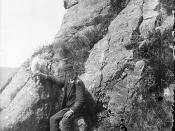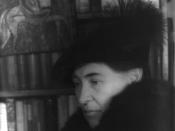The 'strange' can be seen as a description applicable to something unusual or surprising. It can be defined as something difficult to understand or explain, that seems unfamiliar or alien. Unconventional forms of writing also move away from the standard and the expected. In As I Lay Dying, William Faulkner uses abstract forms and structures for his language, and subsequently portrays complex psychological states of his characters. There is a narrative, yet Faulkner strives to dispel meaning throughout the novel. In Willa Cather's Paul's Case, differing physical appearance and subsequent anxiety over identity are portrayed through the protagonist. Physical appearance is presented as strange in Paul's Case, whereas it is the mental interior of the characters that are presented as strange in As I Lay Dying. The ideas of misplacement and struggle feature throughout both stories. Isolation and identity are also key questions for the characters. In both stories, the mother-figure is absent, and there is a deficiency of close relationships creating a destructive alienation.
Memory and reality are also distorted and manipulated, creating a strange sense of 'time'. The subjects of the two stories are from very different backgrounds and societies, yet they both portray the fragility of human existence. There is a distrust of verbal communication, and conversations are tense, halting and often irrelevant in both stories. The miscommunication of the 'self', through different forms of expression such as language, is key to the representation of the 'strange.'Willa Cather represents the 'strange' through Paul's physical appearance and how he is perceived by others. His teachers believe that "there was something about the boy which none of them understood." Cather writes, "each of his instructors felt that it was scarcely possible to put into words the real cause of the trouble" (p.200). She even describes there being "something sort of haunted" about his smile (p.202). Certain words are chosen to signify his 'abnormality' and how he is perceived as alien by others. The adjectives such as 'remarkable', 'peculiarly' and 'abnormally' in the following examples depict how Paul is seen as different; "His eyes were remarkable for a certain hysterical brilliancy, and he continually used them in a conscious, theatrical sort of way, peculiarly offensive in a boy⦠the pupils were abnormally large" (p.199). These images present a mixture of obscure and startling features to Paul's appearance.
At first, Paul is simply described as "tall for his age" (199). However, emphasis on his age increases throughout the novel to portray how "there is something wrong about the fellow" (p.202). He does not fit his age, which parallels his difference from his surroundings; "His clothes were a trifle outgrown... there something of the dandy about him" (p199). His appearance suggests adulthood, yet his actions are disorderly and impertinent, creating a distorted image of adolescence. Cather describes how he is seen by one of the teachers, with his age appearing inverted, "drawn and wrinkled like an old man's about the eyes, the lips twitching even in his sleep" (p.202). This makes us question whether he is in fact a "mere boy" (p.203). He enjoys being in his work uniform, seeing it as "very becoming" (p.204). However he still has a vulnerability, as he is "exceedingly sensitive" about his chest.
There is juxtaposition between his adult appearance and his young mind. For example, when being scrutinised for his behaviour by the school, Cather writes "Older boys than Paul had broken down and shed tears under that ordeal, but his smile did not once desert him" (p.201). Whilst depicting a masculine image, Cather also hints at Paul's inability to feel or portray emotion. He is theatrical and false, and enjoys solitude, "delighted to find no one in the gallery but the old guard" (p.203). "Paul possessed himself of the place," (p.203)and "lost himself" before the Rico painting and during the symphony. He has imaginary relationships, "making a face at Augustus Caesar" and "an evil gesture at the Venus of Milo as he passed her on the stair way" (p.204). This imagination can be seen to represent his childish mind. Towards the end of the short story, he is referred to more as a 'boy', emphasising how he has been naïve in making his plans to escape, only thinking in the short term. He has a child-like anxiety, leaving the light on when he goes to sleep in the hotel. Parts of his physical appearance suggests he is strangely advanced for his years, yet this strangeness is constructed, as his mind is still very much that of a child.
William Faulkner also experiments with a different, 'strange' modern representation, including the use of simplicity, abstract reality, a loss of form and a lack of explanation. For example, right at the start of As I Lay Dying, circumstance is not explained, which contrasts to Paul's Case. The Bundrens live in virtual isolation, "without a significant past and without a sense of any social role to be maintained in the world's face." The rules of syntax are undone and he experiments with new ways of dealing with time. His experimentation with language represents psychological complexity. The reader has an active part in constructing the story, and the monologues portray a sense of alienation. The act of reading the novel is also strange for the readers themselves, as we "are never allowed to be sure what we are reading." The language is disjointed. There is a "dislocation of voice and consciousness" and "language and identity are constantly slithering and blending." We are given fifteen speakers and no less than fifty-nine sections ranging in length from several pages to just one line. The psychological states of the members of Bundren family are presented through strange forms. For example, the past and the present tense are used in reference to the mother Addie, who at this point in the novel is still alive; Darl documents Anse commenting on taking her in the wagon on the journey to Jefferson; "She'll rest easier for knowing it's a good one, and private. She was ever a private woman" (p.15). She is not dead yet here, yet she is already being referred to in the past tense. Cash has an absurd reaction, whilst his leg is being cemented, and he is consequently in pain, saying, "I feel fine⦠I'm obliged to you"(p.201). Vardaman's words are presented with a lack of punctuation and capital letters. For example, when describing how Dewey Dell was calling out to him, his name is written in lower case, and no comas are used; "hollering at me Vardaman you vardaman you vardaman" (p.138). This can be seen to reflect the incessant sound of his sister's demand accurately. Gray says that the novel has "dreamlike and disassociated areas of language," presented as "symbolic gestures rather than [being] naturalistically used." However in the last example, the form and structure that Faulkner uses can be seen to accurately represent how Vardaman hears his sister's words, accurately representing Vardaman's child-like understanding.
The inability to communicate is present in both novels. For example, in Paul's Case, Paul has an instinctive reaction towards his teachers. He has a "physical aversion" that was "unforgettable" (p.200). This portrays Paul's anxiety but also his unwillingness and inability to communicate and become accessible to others. His strange inability is represented physically here. He also has little conversation with the other characters present, and at one point responds to a conversation by merely snapping his teeth (p.213). In As I Lay Dying, words seem strange, meaningless and hollow, even to the reader. They are at times just attributed to a meaning, a perception, with characters having a limit of words or a loss of words leading to a lack of outward communication. The repetition of words and sentences reflects this inadequacy. For example, Dewey Dell talks anxiously about her inability to grieve for her mother, "I wish I had time to let her die. I wish I had time to wish I had. It is because in the wild and outraged earth too soon too soon too soon" (p.107). Faulkner also uses vacancy, a blank space to represent an odd 'lack of meaning', by inserting the shape of a coffin, rather than to describe it with words (p.80). Lack of communication is present between the characters too. For example, Darl writes of a conversation he had with Cash, about when Jewel was born, ""That pillow was longer than him," Cash says. He is leaning a little forward. "I ought to come down last week and sighted. I ought to done it." / "That's right," I say. "Neither his feet nor his head would reach the end of it. You couldn't have known," I say. / "Ought to done it," he says"" (p.131). Darl ignores and does not refer to Cash's last sentence at all, just carrying on with the subject of Jewel.
The power of imagination and the strange alienation from reality is present in both novels. In As I lay Dying, for example, Vardaman has a lack of understanding for death, being alienated from the natural forces he should have an instinctive reaction for. Peter Swiggart describes the significance of Darl and Vardaman as representing "the psychological extremes of madness and childish imagination." They "try in vain" to understand the situation, questioning their personal existence and its relation to their mother. Vardaman, through an act of childish imagination, tries to deny his mother's death by identifying her with a fish he has caught. Dewey Dell also has an inability to feel and understand her pregnancy. In Paul's Case, Paul's alienation, leads him to develop a belief in the unreal. For example, he sees the stage entrance as the actual "portal of Romance" (p.216). Cather writes that "it was at the theatre and at Carnegie Hall that Paul really lived; the rest was but a sleep and a forgetting" (p.215). He has an odd inability to live in reality, what he sees as the mundane, and "a certain element of artificiality seemed to him necessary in beauty" (p.215). Tragically, this inability ultimately leads to his death. He has a love for the unnatural, and needed "only the spark, the indescribable thrill that made his imagination master of his senses"(p.216-7). He feels at home once he escapes to New York, where the flowers blossomed unnaturally and the park was a wonderful "stage winterpiece" (p.224). He continuously distorts reality through lies and inventions. However, even though he can tell a story "plausibly and with no trouble" (p.220), he is still uncomfortable and anxious, even in New York, as he "hastily" puts his flowers in water, and "tumbled" into his hot bath. Cather describes what Paul sees as reality, yet see labels his vision as "Paul's dream" (p.225). The sense of time and the past is distorted - "He doubted the reality of his past. Had he ever known a place called Cordelia street⦠mere rivets in a machine they seemed to Paul... Ah, that belonged to another time and country!" (p.226). His memory is becoming distorted and manipulated into what he wants reality to be. He can only live in his constructed ideology, and "the mere stage properties were all he contended for" (p.226) However, his past comes back to haunt him. At the end of the story, he has a "sickening vividness" and a "sinking sensation that the play was over" (p.229), letting the "tide of realities wash over him" (p.231). At the end, he has a loss of meaning, only remembering vivid meaningless images and details, having an odd sensation of "merciless clearness" about his folly and haste, as he jumps and causes his death (p.234). This ending creates an unexpected relaxed image of understated and poetic loss.
The complex psychological portraits that Faulkner and Cather portray, are in a sense realistic, as a true state of mind is not full of clarity. There is never an objective point of view, in real life, and so Faulkner's use of multiple voices reflects that. Vickery says that the "traditional role of mourners has unspoken propriety and decorum." She then comments that critics have said the characters in As I Lay Dying, can be seen to fail in their behaviour or show an inspiring gesture of humanity or a heroic act of traditional morality. However, Vickery believes it is a "travesty of the ritual of interment". However, the state of mourning is not a 'normal' emotional state. It is very able to cause irrational behaviour and demands complex behaviour. In response to Addie's death, Jewel believes his mother is a horse, similar to Vardaman's belief she is a fish and Darl associates his own lack of personal existence with the absence of a mother. Vardaman is afraid his mother will suffocate, and so drills the holes into the coffin, two of which go into her face, which Swiggart says is a "horrible experience" yet is put in such "ridiculous context that the reader is sheltered from their full impact." These actions may appear strange, yet, as Swiggart says, this is "how they keep their mental equilibrium in the face of bereavement." This emotional state and mental disintegration, is present in reality, and I feel that Faulkner accurately portrays this through the use, and the non-use, of words. In both stories, we are given insight into the character's thoughts. The actions of the characters are odd and surprising. Cather's Paul is said to "assert his difference" (p.228), implying that his 'strangeness' is partly forced, unlike in As I Lay Dying, where their strange actions can be seen as a response to the unavoidable situation of death. The different forms of "strangeness" in these texts can also be seen to reflect the attitudes and anxieties towards the modern changes that were present in the contexts and time periods of these stories.
Bibliography:â¢Cather, Willa, Youth and the Bright Medusa, 'Paul's Case', (New York: Alfred A. Knopf, 1920).
â¢Faulkner, William, As I Lay Dying, (London: Vintage, 2004).
Secondary Criticism:â¢Gray, Richard, The Life of William Faulkner: A Critical Biography, (Oxford: Blackwell Publishers, 1994).
â¢Swiggart, Peter, The Art of Faulkner's Novels, (Austin: University of Texas Press, 1962).
â¢Vickery, Olga, 'The Dimensions of Consciousmess: As I Lay Dying', William Faulkner: Three Decades of Criticism, (USA: Michigan State University Press, 1960).


![[Portrait of Les Paul, Fat Tuesday, New York, N.Y., ca. 1980s] (LOC)](https://s.writework.com/uploads/3/31608/portrait-les-paul-fat-tuesday-new-york-n-y-ca-1980s-loc-thumb.jpg)


